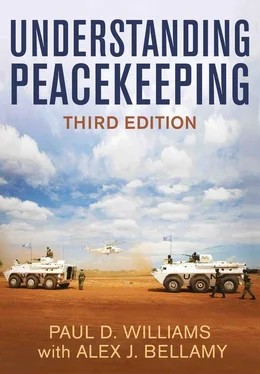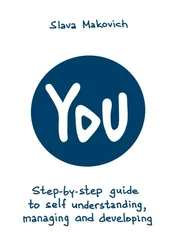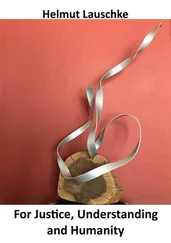5 Abbreviations
6 Acknowledgements
7 Introduction
8 Begin Reading
9 Appendix
10 References
11 Index
12 End User License Agreement
1 Chapter 1 Figure 1.1Levels of analysis for studying peace operations
2 Chapter 2 Figure 2.1Number and type of peace operations, 1947–2019 Figure 2.2Generic structure of a multidimensional peace operation Figure 2.3Authority, command and control in multidimensional UN peacekeeping operations Figure 2.4UN peacekeeping expenditures, 1947–2019 Figure 2.5Models of partnership peacekeeping
3 Chapter 5 Figure 5.1Total number of uniformed UN peacekeepers, November 1990 – September 2019 Figure 5.2Number of ongoing UN peacekeeping operations, 1947–2019 Figure 5.3Number of ongoing UN-authorized and non-UN peace operations, 1947–2019
4 Chapter 7 Figure 7.1The ‘holy trinity’ of traditional peacekeeping
5 Chapter 9 Figure 9.1UN peacekeeper fatalities by year and incident type, 1948 – November 2019
6 Chapter 10 Figure 10.1Mentions of the term ‘stabilization’ in UN Security Council open meetings, 2001–…
7 Chapter 11 Figure 11.1Peace implementation pillars in Bosnia
8 Chapter 12 Figure 12.1United Nations force generation in the pre-deployment phase Figure 12.2Number of countries contributing UN uniformed peacekeepers, November 1990 – Octo… Figure 12.3Uniformed UN peacekeepers provided by the P5, November 1990 – December 2019
9 Chapter 13 Figure 13.1Number of regional peace operations, 1946–2019 Figure 13.2Number of regional and UN peace operations by region, 1946–2019
10 Chapter 14 Figure 14.1Contracts in battlespace Figure 14.2UN procurement statistics by major commodity, 2017 Figure 14.3UN procurement statistics by country of origin, 2017
11 Chapter 15 Figure 15.1UN peacekeeper fatalities by malicious act, July 1948 – June 2019 Figure 15.2UN peacekeepers and fatalities from malicious acts, 1990–2018
12 Chapter 17 Figure 17.1Female uniformed UN peacekeepers, 2005–2019 Figure 17.2Types of female uniformed UN peacekeepers, 2005–2019
13 Chapter 18 Figure 18.1UN police in peacekeeping operations, 1990–2019 Figure 18.2Policing operations organized by activities
14 Chapter 19 Figure 19.1Organized crime and illicit flows in UN Security Council resolutions, 2000–2018
1 Chapter 4 Map 4.1Bosnia and Herzegovina
2 Chapter 5 Map 5.1Sudan and its neighbours
3 Chapter 6 Map 6.1Macedonia
4 Chapter 7 Map 7.1Cyprus Map 7.2UNMEE in Ethiopia and Eritrea
5 Chapter 8 Map 8.1El Salvador Map 8.2Cambodia Map 8.3Rwanda Map 8.4Sierra Leone
6 Chapter 9 Map 9.1Somalia Map 9.2Timor-Leste Map 9.3Eastern-Central Democratic Republic of the Congo
7 Chapter 10 Map 10.1Afghanistan Map 10.2Democratic Republic of the Congo Map 10.3Mali Map 10.4Central African Republic
8 Chapter 11 Map 11.1UNMIK in Kosovo
9 Chapter 13 Map 13.1Liberia
10 Chapter 16 Map 16.1South Sudan
1 Chapter 1 Box 1.1Advocates of liberal peace Box 1.2The global cultural determinants of peace operations
2 Chapter 2 Box 2.1‘Uniting for peace’ in the UN General Assembly Box 2.2Assembling a United Nations peacekeeping operation
3 Chapter 4 Box 4.1Boutros-Ghali on the failure of UN peace operations
4 Chapter 5 Box 5.1The Brahimi Report and the future of peace operations
5 Chapter 6 Box 6.1Ken Menkhaus’s conflict prevention chain Box 6.2Proposals for UN standing forces: a very short history
6 Chapter 7 Box 7.1Hammarskjöld’s principles for the conduct of UNEF I Box 7.2UNEF I’s mandate
7 Chapter 8 Box 8.1UN responsibilities under the Chapultepec Accords Box 8.2UNAMIR: small and cheap
8 Chapter 9 Box 9.1Security Council action under Chapter VII
9 Chapter 11 Box 11.1Institutionalization before liberalization: six priorities Box 11.2Security Council Resolution 1244 and the transitional administration in Kosovo
10 Chapter 12 Box 12.1Training United Nations peacekeepers Box 12.2Key capability gaps in UN peacekeeping operations, May 2017
11 Chapter 13 Box 13.1Boutros-Ghali on the UN and regional arrangements, 1992
12 Chapter 14 Box 14.1The International Stability Operations Association (ISOA) Box 14.2Bancroft Global Development’s support to AMISOM in Somalia Box 14.3Executive Outcomes in Angola, 1993–5
13 Chapter 17 Box 17.1Barriers to the deployment of uniformed women in peace operations
14 Chapter 18 Box 18.1United Nations police mandated tasks, most to least frequent, 1995–2013 Box 18.2Types of police peacekeepers Box 18.3Traditional policing in ONUMOZ Box 18.4Executive policing in Kosovo
15 Chapter 19 Box 19.1Blue helmets and black markets in the siege of Sarajevo
1 Chapter 1 Table 1.1Westphalian, post-Westphalian and stabilization approaches
2 Chapter 2 Table 2.1Peace operations: a typology with examples Table 2.2Old and new UN peacekeeping scales of assessment
3 Chapter 3 Table 3.1The United Nations: lessons learned? Table 3.2UN-led peace operations, 1945–1987 Table 3.3Examples of larger non-UN peace operations, 1947–1987
4 Chapter 4 Table 4.1Explaining the triple transformation Table 4.2UNPROFOR’s changing mandate Table 4.3Key DPKO recommendations from its Comprehensive Report on … UNAMIR (1996)
5 Chapter 5 Table 5.1Implementing the Brahimi Report: a contemporary scorecard
6 Chapter 8 Table 8.1Problems and success factors in assisting transitions
7 Chapter 9 Table 9.1Chapter VII resolutions, 1946–1989
8 Chapter 11 Table 11.1Contending approaches to transitional administrations
9 Chapter 13 Table 13.1Examples of peace operations conducted by regional organizations since 1990
10 Chapter 14 Table 14.1The variety of arrangements for allocating violence
11 Chapter 16 Table 16.1Caveats in UN protection of civilians peacekeeping mandates
12 Chapter 17 Table 17.1SEA allegations in UN peace operations, 2007–2019
13 Chapter 18 Table 18.1Top ten UN police contributors in the twenty-first century
14 Chapter 20 Table 20.1Potential modes of exit for peace operations
Читать дальше












